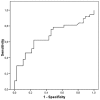'Functional connectivity' is a sensitive predictor of epilepsy diagnosis after the first seizure
- PMID: 20520774
- PMCID: PMC2877105
- DOI: 10.1371/journal.pone.0010839
'Functional connectivity' is a sensitive predictor of epilepsy diagnosis after the first seizure
Abstract
Background: Although epilepsy affects almost 1% of the world population, diagnosis of this debilitating disease is still difficult. The EEG is an important tool for epilepsy diagnosis and classification, but the sensitivity of interictal epileptiform discharges (IEDs) on the first EEG is only 30-50%. Here we investigate whether using 'functional connectivity' can improve the diagnostic sensitivity of the first interictal EEG in the diagnosis of epilepsy.
Methodology/principal findings: Patients were selected from a database with 390 standard EEGs of patients after a first suspected seizure. Patients who were later diagnosed with epilepsy (i.e. > or = two seizures) were compared to matched non-epilepsy patients (with a minimum follow-up of one year). The synchronization likelihood (SL) was used as an index of functional connectivity of the EEG, and average SL per patient was calculated in seven frequency bands. In total, 114 patients were selected. Fifty-seven patients were diagnosed with epilepsy (20 had IEDs on their EEG) and 57 matched patients had other diagnoses. Epilepsy patients had significantly higher SL in the theta band than non-epilepsy patients. Furthermore, theta band SL proved to be a significant predictor of a diagnosis of epilepsy. When only those epilepsy patients without IEDs were considered (n = 74), theta band SL could predict diagnosis with specificity of 76% and sensitivity of 62%.
Conclusion/significance: Theta band functional connectivity may be a useful diagnostic tool in diagnosing epilepsy, especially in those patients who do not show IEDs on their first EEG. Our results indicate that epilepsy diagnosis could be improved by using functional connectivity.
Conflict of interest statement
Figures




References
-
- Litt B, Echauz J. Prediction of epileptic seizures. Lancet Neurol. 2002;1:22–30. - PubMed
-
- Timofeev I, Steriade M. Neocortical seizures: initiation, development and cessation. Neuroscience. 2004;123:299–336. - PubMed
-
- King MA, Newton MR, Jackson GD, Fitt GJ, Mitchell LA, et al. Epileptology of the first-seizure presentation: a clinical, electroencephalographic, and magnetic resonance imaging study of 300 consecutive patients. Lancet. 1998;352:1007–1011. - PubMed
-
- Noachtar S, Remi J. The role of EEG in epilepsy: a critical review. Epilepsy Behav. 2009;15:22–33. - PubMed
-
- Marsan CA, Zivin LS. Factors related to the occurrence of typical paroxysmal abnormalities in the EEG records of epileptic patients. Epilepsia. 1970;11:361–381. - PubMed
Publication types
MeSH terms
LinkOut - more resources
Full Text Sources
Medical

